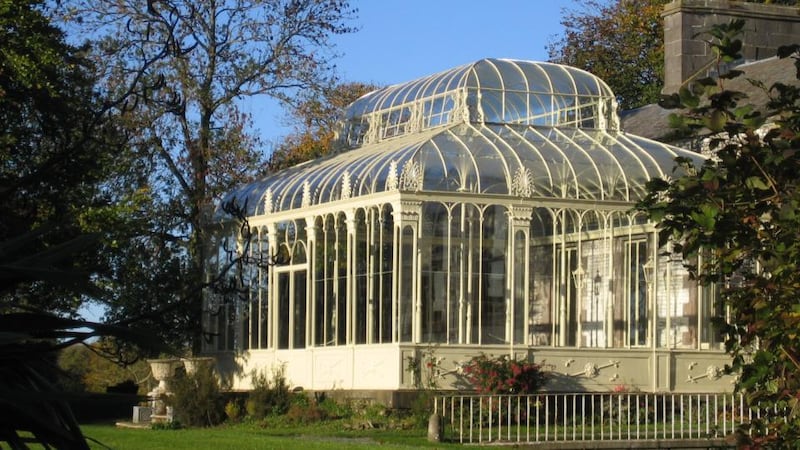En route to Killala to meet John Hogan at his forge, I was anticipating the "door into the dark", the "unpredictable fantail of sparks" not to speak of the "hammer anvil's short-pitched ring", sights and sounds of a blacksmith's vividly described by Seamus Heaney in The Forge.
But Hogan was not beating iron out that day and all was quiet in his workshop and showroom located in the now-abandoned Asahi factory outside Ballina. "The Japanese lads used to have their dinner here," he smiles, waving his hand around the former canteen which now houses displays of his steel artistry and awards.
Pride of place is a massive, ornate steel bed composed of swirling curlicues and scrolls, sections of brass-railed staircases, steel-legged tables and smaller pieces such as maquettes destined to be bigger sculptures. One called Dole, a column of miniature standing stones ending with a door, was done on a whim, he explains.

“They were left over pieces from a gate at St Patrick’s College in Dublin and when I cut them off they looked like little figures, so I put in a door at the end so it looked like a dole queue – a familiar sight at that time”, he recalls ruefully.
Racks of iron and steel
Two of his sculptures are now familiar landmarks in Ballina – one on a roundabout is called
Bradanach
or salmon, a leaping fish in shiny stainless-steel inset with 50 smaller salmon shapes. Also commemorating the town’s fame as a fly-fishing capital is another, a 15ft-high flamboyant flourish of steel, commissioned by
Hollister
, the US medical products company, in Ballina two years ago, inspired by the swirl of the fly fishermen’s lines on the Moy.
In his workshop, fierce-looking, heavy- duty machinery – lathes, forges, power hammers, steel-shaping presses, rolling, sandblasting and lifting equipment – line the walls alongside racks of iron and steel, the hefty materials that he beats into shape. “The machines allow you to do the same thing by hand, but on a bigger scale”, explains. “I work with big stuff, but the machines take the load.” One side of a huge metal gate for a house in Sligo, for example, rests on clamped trestles awaiting completion.
“What I love about this work is that it has so many areas – I can change from gates to sculpture, from large pieces to restoration work and bespoke furniture, which keeps it interesting,” says this bearded and stocky young guy whose career in decorative ironwork developed almost by chance.
“At school, there was no metalwork, but I was quite good at woodwork and had very little interest in anything else. When I finished, I heard that a new course on blacksmithing had just opened in Belmullet. I’d love to say I wanted to do it, but to be honest I wanted to head to Dublin straight out of school like a bat out of hell.”
In the event, he became the youngest of 12 to sign up for the two-year intensive course where he was trained by American, English and Irish master blacksmiths. “I took to it straightaway,” he says, adding that he finished top of the class. At one point, his work experience took him to a forge in Norwich where the artist/blacksmith Bill Corduroy introduced him to the camaraderie of others working in the craft.
His final-year project, a swinging bench, caught the eye of one of the judges, Colm Bagnell of Bushy Park Ironworks in Dublin, who immediately offered him a job. "So I went to Dublin and stayed for five years and learned a lot – it was at the height of the boom and it got me from small to large-scale work and removed any sense of limitations I had of what was possible," he recalls. There were elaborate indoor staircases for rich clients, gates for private wine cellars, traditional and modern railings, gates for Birr Castle and Trinity College, and other interesting commissions.
After five years, he decided to set up his own company, Iron Excellence, back home in Mayo and since then, through word of mouth and his website, has attracted interesting private as well as public projects including garden sculpture for Ruth Liddle at Bloom, gates and staircases for private clients and the restoration of a 19th-century curvilinear conservatory in Louth, which took a year to complete.
Possibilities are endless
“We stripped the entire thing down, tagged every piece, mapped everything in wrought and cast iron, and remade the curved top. It took three months to put together.” The building is now shortlisted for an award. Some of his pieces have even travelled to Australia and New York.
Working in tandem with clients, he sketches designs, transfers them to a timber template from which the pieces are forged in steel. “My work would be art nouveau in style in its flow. I like clean lines and organic shapes – I can’t stand things that don’t flow properly. The quality has to be right. A lot is about testing your own limits and moving forward design and scale- wise.
“I work with architects, interior and garden designers, conservation and heritage officers and after all that, it is nice to design your own pieces. The possibilities are endless. When you can create something unique, that’s where the excitement comes in.”
ironexcellence.com











